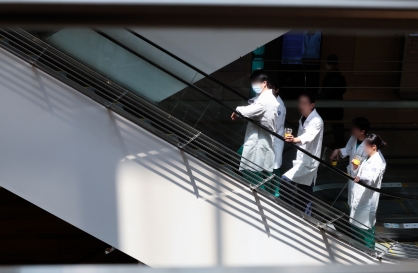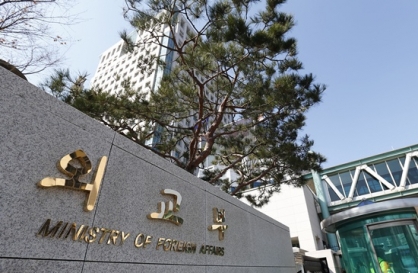Excessive demand forecast, minimum revenue guarantee add to fiscal burden
An apology was recently posted at stations on Seoul subway line No. 9. The line operator apologized for its abrupt notice of the plan to raise fares. It said it would temporarily postpone the fare hike, which it had sought to implement from June 16.
Last month, the private operator of Seoul subway line No. 9 shocked citizens with an abrupt notice of its decision to raise fares by 500 won. The company later caved in under strong pressure from the Seoul Metropolitan Government and revoked the announcement. Nonetheless, tension remains between the private operator Seoul Metro Line 9 Corp. and Seoul City over the fee hike.
It is not only subway line 9 that is involved in conflicts over revenue from the operation of public facilities which took private-sector investment.
An apology was recently posted at stations on Seoul subway line No. 9. The line operator apologized for its abrupt notice of the plan to raise fares. It said it would temporarily postpone the fare hike, which it had sought to implement from June 16.
Last month, the private operator of Seoul subway line No. 9 shocked citizens with an abrupt notice of its decision to raise fares by 500 won. The company later caved in under strong pressure from the Seoul Metropolitan Government and revoked the announcement. Nonetheless, tension remains between the private operator Seoul Metro Line 9 Corp. and Seoul City over the fee hike.
It is not only subway line 9 that is involved in conflicts over revenue from the operation of public facilities which took private-sector investment.

Yongin light rail transit
A private finance initiative is a way of creating public-private partnerships by funding public infrastructure projects with private capital. There have been adverse consequences in infrastructure projects pushed as private finance initiatives, though, including the light rail transit in Yongin, Gyeonggi Province.
The Yongin transit is still not in use two years after construction was completed in June 2010. The stoppage of the costly project invited sharp criticism of the city government for causing a fiscal crisis.
The failure to begin operations has been attributed to overestimation of traffic demand and the minimum revenue guarantee clause of the contract between the city and the operator.
The minimum revenue guarantee, which obliges Yongin City to ensure a certain level of revenue no matter how much is brought in through ticket sales, is blamed as the main culprit for the project’s financial woes.
Yongin entrusted a private investor with the right to operate the light rail transit on condition of investment of 630 billion won. It also guaranteed a level of revenue, which was calculated based on the demand forecast. However, the forecast went awry, and the deficit ballooned to an estimated 3.4 trillion won and prompting a crisis.
In the end, a former Yongin mayor was arrested for irregularities over the project. The city managed to reduce the minimum revenue guarantee through renegotiation, and agreed to start the operation of the transit in April 2013. Even if so, the city government is to pay a huge amount in compensation.
Yongin Light Rail Transit may be recorded as the most typical case of a public facility project gone awry, which revealed the clumsy side of a deal achieved through private finance initiative.
Demand overestimation
The guaranteed revenue clause has had such a devastating effect because the level of traffic was so massively overestimated.
The Korea Transport Institute originally projected the number of daily passengers on the Yongin light rail transit to reach 183,000 in 2011 and 228,000 in 2036. Gyeonggi Research Institute recently revised the demand forecast downward to 32,000 in 2011 and 72,000 in 2036.
The resulting shortfall in fare revenues has to be made up for by the local government through the guarantee clause. If the private company opens and operates the Yongin light rail transit in accordance with the original deal, the city government would have to provide 79.9 percent of the private firm’s share of the project cost. The annual minimum revenue guarantee amounts to 85.7 billion won and the 30-year accumulated revenue guarantee would reach 2.571 trillion won.
To get the transit system running, the city restructured the deal with the light rail operator in April. They agreed to switch from a minimum revenue guarantee to a new subsidy scheme. Yongin officials expect to save 1.6 trillion won in the new deal.
Yongin is not the only city faced with PFI problems. Light rail transit projects are under way in 11 other cities, and their total costs amount to 15.05 trillion won.
According to a report on the problems of light rail projects, published by the National Assembly Research Service in April, the initial demand forecast for the light rail transit linking Busan to Gimhae was 176,358 passengers annually. The actual number of passengers after the line was opened in February was 31,000, one-sixth that of the estimate. Demand in 2030 was recently revised downward to a range of 50,000 to 100,000.
The minimum revenue guarantee by the local government over the Busan-Gimhae rail project until 2030 totals 1.6 trillion won.
“The project’s problems seem to come from the lack of consideration of the tight budget by elected heads of local governments who are overly eager to fulfill residents’ expectations for regional development,” an official of the National Assembly Research Service said.
“An excessive demand forecast, combined with minimum revenue guarantees intended to attract private investment in costly infrastructure projects, has led to the covering of large deficits with taxpayers’ money.”
Like the Yongin light rail transit project, the recent controversy over fees on Seoul subway line No. 9 also involves inflated demand forecasts and a minimum revenue guarantee.
The fiscal burden of expressways
Privately invested expressways also impose a heavy fiscal burden on local governments, which have to make up for losses due to a lighter-than-anticipated traffic to meet the minimum revenue guarantee. The deficit covered until the end of last year for nine expressways built under the private finance initiative program exceeds 1.6 trillion won.
The largest deficit coverage comes from the highway linking Seoul to Incheon International Airport. The amount topped 900 billion won.
Like other projects, it is minimum revenue guarantee that caused much of deficit covering for highways built with private investment. The authorities overused the guarantee in the late 1990s when the country was in a desperate need of private investment to overcome the financial crisis which drove Seoul to seek a bailout from the International Monetary Fund. The guarantee was a kind of incentive to induce investment.
That is, if actual traffic turned out to be smaller than forecast and as a result the private investor suffered a deficit between estimated and actual revenue, the government promised to cover the shortfall up to 80 to 90 percent of estimated revenue. The government guarantee of 80 to 90 percent of estimated revenue was a surefire incentive for private investors, who strove to win projects while maximizing demand forecast.
According to a Korea Development Institute report on measures for rational decision-making on social overhead costs, the average traffic estimate error for national highways opened from 2002 to 2006 and expressways opened since 2000 was up to 22.39 percent.
The demand forecast were also off for Woomyunsan Tunnel, a major privately financed project in Seoul. Seoul Development Institute forecast eight years ago that daily traffic through the tunnel would be about 62,000 cars this year, but last year revised its prediction sharply downward to about 27,000 units.
Overly optimistic forecasts
Why such a wide gap between the forecast and actual demand? Experts say it is a result of a good match of three-way interests among residents, local governments and private investors or builders. Residents want their region to be developed with infrastructure projects such as a subway line or station, while local governments facing fiscal difficulties want outside investment and builders want large guaranteed revenue.
On public facility projects, private investors and local authorities have a shared interest in higher demand forecasts. For local governments it secures investment and highlights the economic necessity of the projects, for the companies, it maximizes revenue. Needless to say, the higher the demand forecast, the larger the minimum revenue guarantee becomes in amount terms.
“Private investors or builders have basic attributes to maximize profits even from public goods,” said Park Jin, executive director of the Research Center for State-Owned Entities of the Korea Institute of Public Finance.
But there is an objection to the view that demand seemed to be intentionally inflated.
“It is never an easy job to make a correct forecast of demand five or 10 years from now. For example, 15 years ago, nobody had the slightest idea that the population or the number of cars would decrease,” Park Yong-seok of Construction and Economy Research Institute of Korea said. “The demand forecast was often way off not only for privately financed infrastructure projects but also in formulating fiscal policies.”
Deficit covering until contracts will expire
As the deficit to be covered on the minimum revenue guarantee deal snowballed every year, the government did away with the guarantee system in 2009.
Still, the contract period of most of the privately financed projects is 20 to 30 years, so trillion won in taxpayers’ money is expected to be used to cover deficits until the contracts expire, unless demand and operating revenues surge over the guaranteed level.
The number of privately funded projects, according to the Board of Audit and Inspection last year, was 116 as of late 2009, 70 of which have minimum revenue guarantees. The number of those projects whose deficits were made up by the government was 29.
The board said that deficit covered for the 29 projects which were in the red from 2001 to 2009 totaled 2.2 trillion won. The agency estimates that if this trend continues, the costs will reach 18.8 trillion by 2040.
According to a report on problems of privately financed infrastructure projects, prepared by the National Assembly Research Service for Rep. Park Joo-sun, demand forecast for Build-Transfer-Operate projects were excessively inflated. Actual traffic volume of privately funded roads ― except for a ring road circling Seoul (93.3 percent) ― was more than 60 percent lighter than forecast.
The report said that as a result of excessive demand forecast and minimum revenue guarantees, 488.2 billion won was injected to cover deficits of BTO type projects in 2011 alone. The figure is 7.5 times 65.3 billion won spent for the same purpose in 2002.
Measures and experts’ view
The government needs to work out measures to prevent excessive demand forecasts for private finance initiative projects, the report said.
“The covering of deficit is inevitable because the government is bound by the minimum revenue guarantee contract as long as it maintains the deal,” Yoon Soon-cheol of Citizens’ Coalition for Economic Justice said.
“The government needs to analyze and compare expected deficit coverage from contract maintenance and costs from possible annulment of contact, then make a choice toward minimizing tax burden.”
Experts say it is problematic to allow mayors or heads of provincial government offices to seek privately financed projects such as light rail. It is because many elected heads of provincial government offices promise and push pork barrels without close consideration of regional traffic demand and fiscal status.
“The government should keep three principles: policy transparency, project marketability and project competitiveness to induce creativeness and efficiency from the private sector,” Park of CERIK said. “Given that infrastructure is necessary and that the government and state enterprises have limits in raising funds, it is impossible to exclude private capital. Systems need to be in place to secure these three principles.”
Yoon of Citizens’ Coalition for Economic Justice agreed: “It is important to make contract procedures transparent. Civil servants and private builders keep secret their negotiations over infrastructure projects. Generally, private builders are superior to public officials in business negotiations. Negotiations should be transparent.”
By Chun Sung-woo (swchun@heraldcorp.com)
-
Articles by Korea Herald




![[Weekender] Korean psyche untangled: Musok](http://res.heraldm.com/phpwas/restmb_idxmake.php?idx=644&simg=/content/image/2024/05/02/20240502050841_0.jpg&u=)




![[Eye Interview] 'If you live to 100, you might as well be happy,' says 88-year-old bestselling essayist](http://res.heraldm.com/phpwas/restmb_idxmake.php?idx=644&simg=/content/image/2024/05/03/20240503050674_0.jpg&u=)








![[Herald Interview] Director of 'Goodbye Earth' aimed to ask how we would face apocalypse](http://res.heraldm.com/phpwas/restmb_idxmake.php?idx=652&simg=/content/image/2024/05/03/20240503050732_0.jpg&u=)
